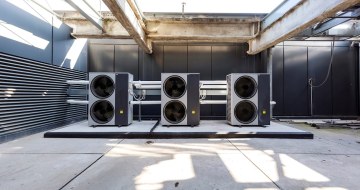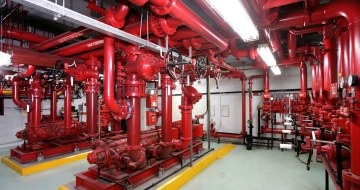
August 8, 2024 in Advisory Notes
Operational Analytics and Data Driven Maintenance (DDM)
Mould plays an important role in the natural environment as a break-down mechanism for dead organic matter. In the built environment, it is an unwante...
June 24, 2024
Mould requires three factors to be simultaneously present to
germinate and propagate:
In a similar fashion to extinguishing a fire, the existence of mould indoors can be controlled by eliminating one or more of these factors. In all but the cleanest of environments mould spores and organic matter will be present to some degree, and moisture is often the catalyst of many outbreaks. Once an outbreak is established it is important to control all three elements to eradicate mould colonies and prevent their re-occurrence.
When mould colonies form in a closed indoor environment, they release millions of spores which can circulate through a building’s ventilation system, causing indoor levels to reach concentrations that are hundreds of times higher than ambient levels.
For most people the presence of mould will be a minor irritant, possibly triggering sneezing, coughing or minor inflammation. For those with allergies it may lead to more pronounced inflammation, eye irritation, skin rashes or asthmatic breathing difficulties. In some circumstances, mould can lead to more serious consequences – particularly with immunocompromised individuals.
For this reason, the presence of mould in healthcare facilities, and in particular acute care settings such as cancer wards, is a serious issue which must be monitored and treated accordingly.
Managing moisture in buildings is typically the key factor in preventing and controlling mould growth. Without moisture mould reproduction cannot occur, and existing mould colonies will die. Water leaks, condensation, groundwater, poor drainage and/or elevated humidity are contributing factors towards starting and sustaining a mould outbreak.
Moulds are a type of fungus – living organisms which require a source to grow and propagate. They feed on organic matter. Building materials such as timber, paper, natural fabrics and leather will be susceptible to mould growth under the right conditions.
A build-up of dust containing dead skin cells and other organic matter can also lead to conditions suitable for mould to grow on otherwise inorganic surfaces, such as air handling plant-cooling coils. A regular cleaning regime is important to prevent these conditions from occurring.
Mould reproduces by forming microscopic spores that disperse into the air and settle elsewhere as new potential host sites. Outdoor air normally contains some level of these airborne spores and as such they are introduced at low concentrations on a constant basis via the air handling plant regardless of whether active mould colonies already exist in the building.
This ingress of new mould spores can be reduced by ensuring that the source location of outside air is not damp, dark or contaminated with decaying organic matter.
Mould spores range from 1 to 100 microns in size with the majority between 2 and 20 microns. High-efficiency particulate air (HEPA) filtration can be used on the incoming outside air to remove mould spores however this is often impractical.

HVAC systems play an important role in preventing, controlling and remediating mould outbreaks in the built environment.
High humidity levels and low airflow create conditions where mould spores may be more likely to germinate and propagate. Controlling the HVAC system to maintain indoor conditions within a 40-60% relative humidity range is an important factor in preventing this from occurring.
For more critical environments such as hospitals, museums and art galleries it is important to ensure HVAC systems are designed to include active humidity control. This can be through the use of additional cooling and heating coils for overcooling and reheating of air to remove moisture.
HVAC systems can also be a common cause of mould issues when inadequately maintained. Cooling coils are a source of moisture from condensation on the cold surface. It is important that coil condensation is well drained to avoid moisture build up or leakage. Additionally, air flow velocities through cooling coils should be kept within good design limits to avoid condensate carry-over into downstream ductwork – particularly when internally lined with porous insulation. This is sometimes an issue in modified systems.
Air filters should be replaced at recommended intervals and cooling coils kept clean as part of the maintenance schedule. For HVAC systems serving critical environments the use of ultraviolet lamps should be considered to constantly irradiate cooling coils to kill mould spores and bacteria.
Correctly-designed and specified HVAC filter media will help trap both mould spores and any airborne organic matter, preventing their travel to a moist cooling coil where outbreaks can occur and spread. It is important that air filter banks are well sealed.
When the presence of mould is verified, it is important to ensure that all contaminated sites are located and dealt with promptly to remove the colonies and prevent further spread of spores.
Following a mould outbreak, air filters will likely be contaminated with mould spores and should all be replaced simultaneously to prevent cross-contamination from occurring.
It is recommended that a full filter change be performed immediately to remove the dirty filters already laden with spores from the facility, and then a further filter change upon completion of the rest of the remediation actions to dispose of any trapped spores which would have been dislodged by the remedial works occurring.
Once visible mould colonies have been removed, it may be necessary to remove contaminated sections of ductwork insulation or other porous elements such as attenuators which may have become loaded with mould spores during the outbreak.
Mould colonies can be removed from cooling coils by applying a coil cleaner agent and washing down. This will remove active mould colonies along with inactive spores and flush any trapped organic matter from the coils, preventing the establishment of new growth as well as freeing up airflow and improving the efficiency of the coil.
Coil cleaning should be scheduled as a preventative maintenance activity and not used only as a reactive step when outbreaks occur. Typically, an annual coil cleaning regime should be appropriate.
Coils should be inspected during routine HVAC maintenance inspections when air filters are checked, and cleaned more regularly if any contamination is reported.
General good housekeeping and cleanliness of plant room areas is an important factor in avoiding and remediating a mould outbreak. Keeping plant rooms tidy, clutter-free and clean of dust and grime helps to prevent ingress of organic matter into the air handling plant and eventually ending up the moist environment within the cooling coil chambers and beyond.
As a priority all plant rooms should be cleaned out and left clutter and dirt-free. Any signs of visible mould on walls, floors and surfaces should be cleaned using a vinegar-based solution or hospital-grade disinfectant and dried thoroughly.
Andrew Bagnall
Leader – Technical Advice (NSW/ACT)
A.G. Coombs Advisory
+61 431 238 654
abagnall@agcoombs.com.au

August 8, 2024 in Advisory Notes
Mould plays an important role in the natural environment as a break-down mechanism for dead organic matter. In the built environment, it is an unwante...

April 30, 2024 in Advisory Notes
A lot has changed since A.G. Coombs released our first Advisory Note on heat pumps back in 2018. Increasingly, asset owners are no longer asking if he...

March 12, 2024 in Advisory Notes
Building owners and facility managers often don’t have access to a full set of accurate documentation for of their buildings to support effective an...

October 4, 2023 in Advisory Notes
As the construction and property sectors continue to develop and embrace new technologies including digital twins, cognitive buildings, artificial int...